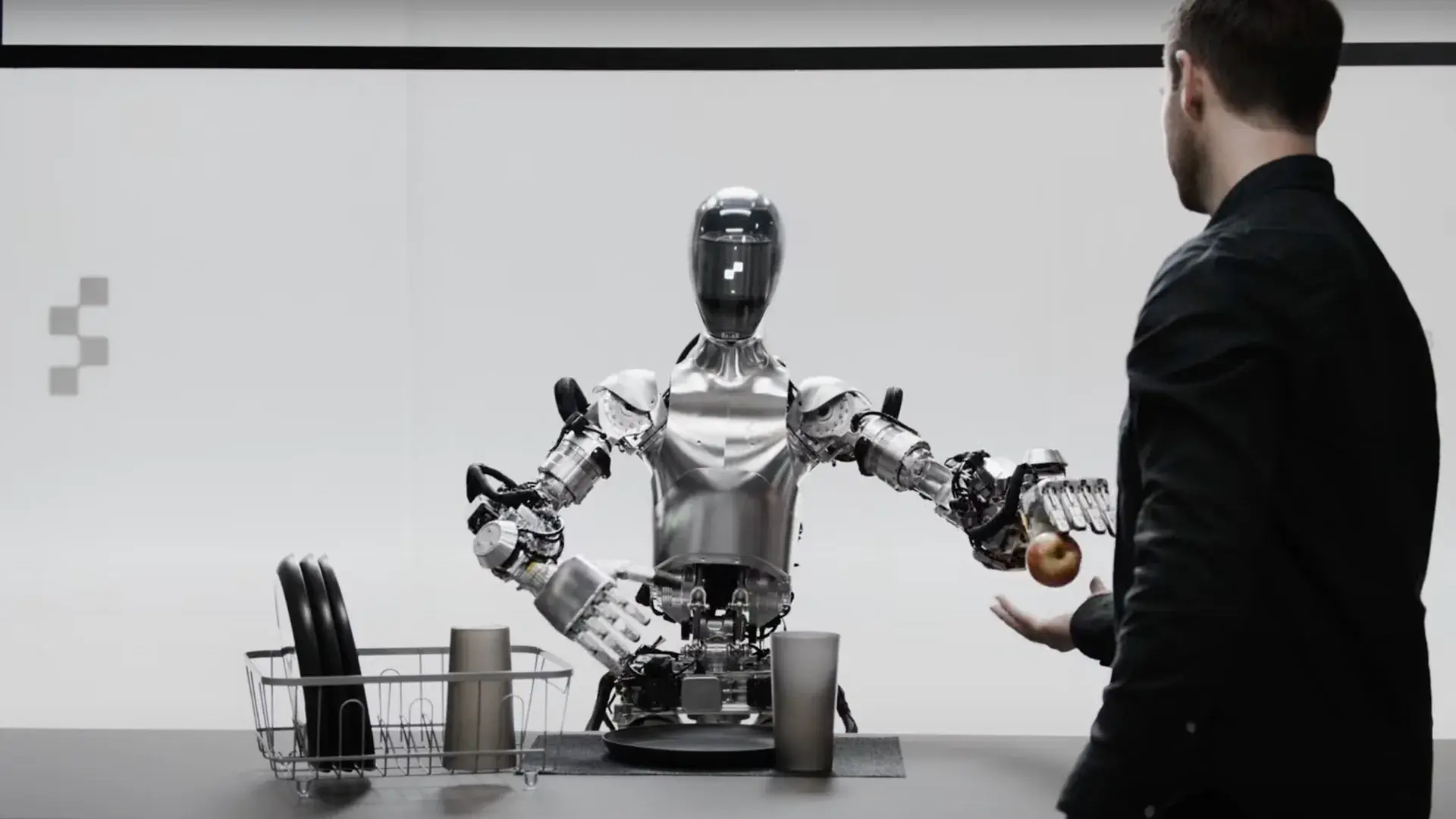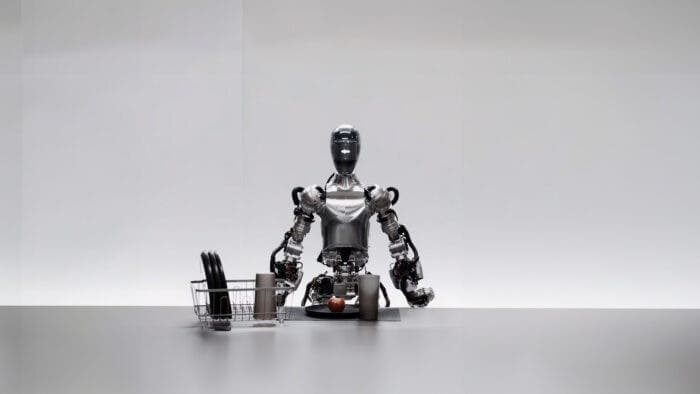A recent demonstration by robotics startup Figure showcases the potential of OpenAI’s ChatGPT technology in powering human-like conversations for humanoid robots. This development brings us closer to a future where robots can seamlessly integrate into our lives through natural language interaction.
Humanoid Robots Take a Step Closer to Natural Interaction with OpenAI’s Language Processing

Figure is building a general-purpose robot, Figure 01, designed to automate tasks currently deemed undesirable or unsafe for humans. Partnering with OpenAI in January 2024, they aimed to enhance the robot’s capabilities in perception, reasoning, and interaction. The newly released video offers a glimpse into these advancements.
Through OpenAI’s language models, Figure 01 can now interpret its surroundings and engage in conversation. The video demonstrates the robot’s ability to identify objects, understand general commands, and respond accordingly. When presented with an apple and asked for food, Figure 01 recognizes the apple as edible and fulfills the request. Notably, the robot explains its reasoning, highlighting its capacity to not only react but also provide context to its actions.
Figure 01 further demonstrates its understanding of broader situations. It gathers nearby trash upon a simple command and even recognizes the need to move empty dishes to a drying rack. While the robot takes a moment to process each instruction, its ability to grasp the intent behind general commands signifies a significant step towards intuitive human-robot interaction.
The official launch date for Figure 01 remains undisclosed. However, the collaboration with OpenAI underscores their commitment to accelerating the commercial deployment of these robots. This development has the potential to revolutionize various industries by introducing robots that can not only perform tasks but also collaborate effectively with human workers through natural language.
The future of humanoid robots with natural language processing
The future of humanoid robots with natural language processing (NLP) holds immense promise for revolutionizing human-robot interaction. Here are some potential areas of growth:
Enhanced Collaboration: Imagine robots seamlessly integrating into workplaces, understanding spoken instructions, and even offering suggestions to improve workflows. NLP can empower robots to become collaborative partners, not just replacements, for human workers.
Improved Caregiving: Humanoid robots equipped with NLP could provide companionship and assistance to old people or those with physical limitations. They could understand and respond to requests, offer reminders, and even engage in conversation to combat loneliness.
Advanced Education and Training: NLP-powered robots could personalize learning experiences by tailoring their communication style to individual students. They could answer questions, provide feedback, and act as tireless tutors, making education more accessible and engaging.
Next-Level Customer Service: Customer service interactions could be transformed by robots that can understand natural language, answer complex questions, and even navigate emotional nuances. This would streamline processes, improve customer satisfaction, and free up human agents for more intricate tasks.
Universal Accessibility: NLP can bridge the communication gap for people with disabilities. Robots could translate sign language, convert speech to text, and vice versa, fostering greater social inclusion.
Challenges to Address:
While the future is bright, there are challenges to consider:
Ethical Concerns: As robots become more sophisticated, questions surrounding ethical treatment and potential job displacement will need to be addressed.
Safety and Security: Robust safeguards must be implemented to ensure robots operate safely and securely, mitigating potential risks associated with advanced AI.
Bias and Fairness: NLP algorithms can inherit societal biases. Addressing these biases is crucial to ensure robots interact with everyone fairly and without prejudice.
Revolutionizing Workplaces: NLP can usher in a new era of human-robot collaboration. Robots won’t just perform tasks; they’ll understand spoken instructions, adapt to changing situations, and even offer suggestions for improved efficiency. Imagine a factory assembly line where robots not only handle parts but also verbally coordinate with human workers, dynamically adjusting the workflow for optimal results. This collaborative approach could significantly enhance productivity and safety in various industries.
The Delicate Dance of Caregiving: Humanoid robots with NLP have the potential to transform eldercare and assisted living. Imagine a robot companion that can not only understand requests for help but also engage in conversation, reducing feelings of isolation and loneliness. However, ethical considerations arise. Can robots ever truly replace human connection and empathy, especially for those in vulnerable states? Striking the right balance between technological assistance and genuine human care will be crucial.
The Democratization of Education: NLP-powered robots hold the potential to personalize learning experiences on a massive scale. A robot tutor equipped with NLP could tailor its explanations and communication style to each student’s needs, providing immediate feedback and addressing learning gaps in real-time. This could revolutionize education, making it more accessible and engaging for students of all backgrounds and learning styles. However, ensuring equal access to such technology will be vital to prevent further educational disparities.
Beyond Customer Service: NLP can elevate customer service interactions far beyond scripted responses. Robots that understand natural language, including humor, sarcasm, and frustration, could streamline processes and improve customer satisfaction. Imagine a customer explaining a complex issue to a robot, and the robot not only understands the problem but also suggests solutions in a way that feels natural and helpful. This would free up human agents for more intricate tasks and create a more positive customer experience.
Bridging the Communication Gap: NLP can be a powerful tool for inclusivity. Robots that translate sign language, convert speech to text, and vice versa, can bridge the communication gap for people with disabilities. This technology has the potential to break down barriers and foster a more inclusive society. However, ensuring these robots are readily available and accessible to all remains a challenge.
Challenges on the Horizon: While the future is promising, significant hurdles need to be addressed. Ethical considerations surrounding job displacement and the potential for robots to exacerbate societal inequalities must be carefully considered. Robust safety and security measures will be crucial to mitigate potential risks associated with advanced AI. Additionally, addressing inherent biases within NLP algorithms is essential to ensure robots interact fairly and without prejudice.
The Road Ahead: Humanoid robots with NLP represent a powerful upcoming technology. By thoughtfully navigating the challenges and prioritizing ethical development, we can harness this technology to create a future where robots work alongside us, not against us. This future holds the potential to improve our lives in countless ways, from revolutionizing workplaces to fostering a more inclusive society. The key lies in responsible development, ensuring that these advancements benefit all of humanity.
Overall, the future of humanoid robots with NLP is brimming with possibilities. By thoughtfully navigating the challenges, we can harness this technology to create a future where robots work alongside us, improving our lives in numerous ways.
The future of humanoid robots with natural language processing (NLP) presents a fascinating landscape brimming with both immense potential and crucial hurdles to navigate. Here’s a deeper dive into this evolving field:





